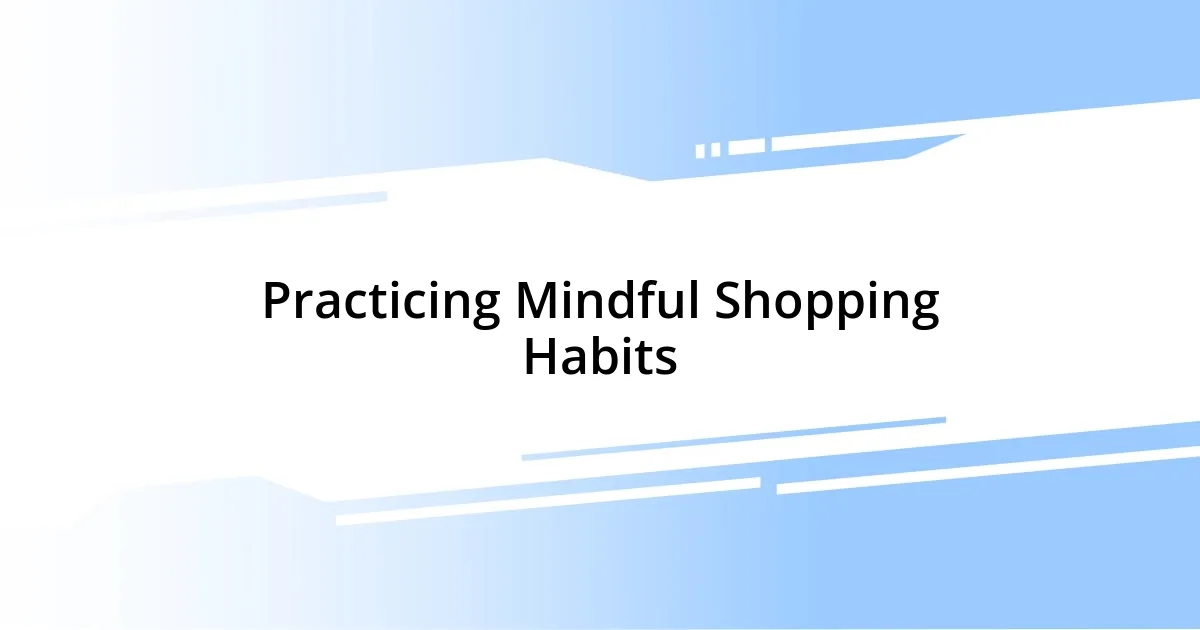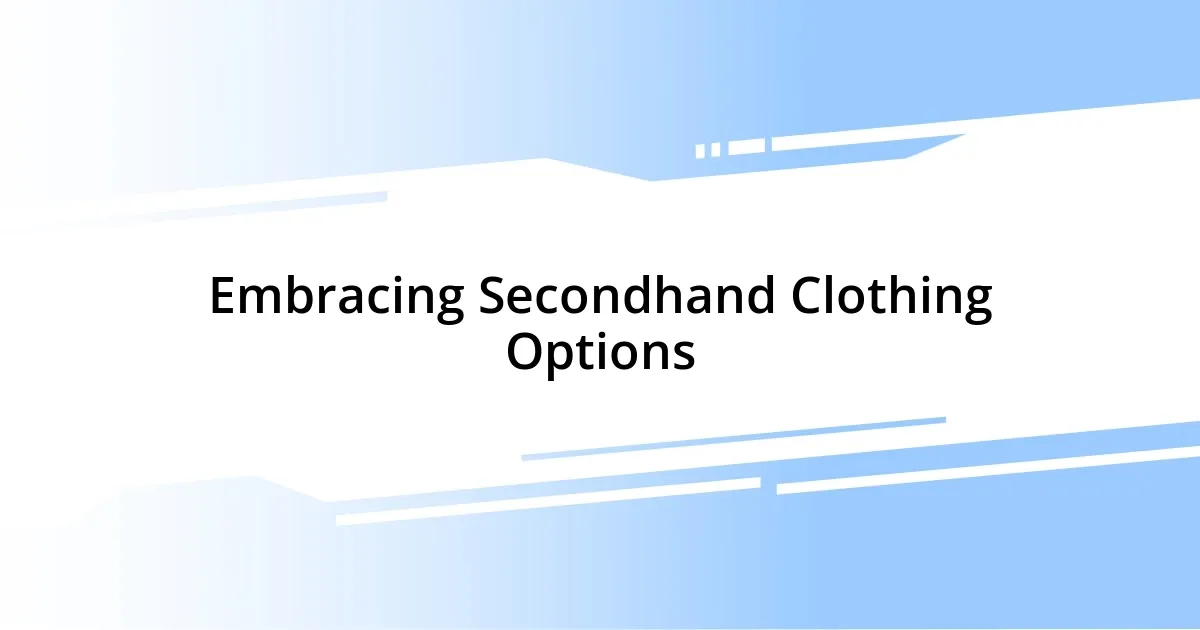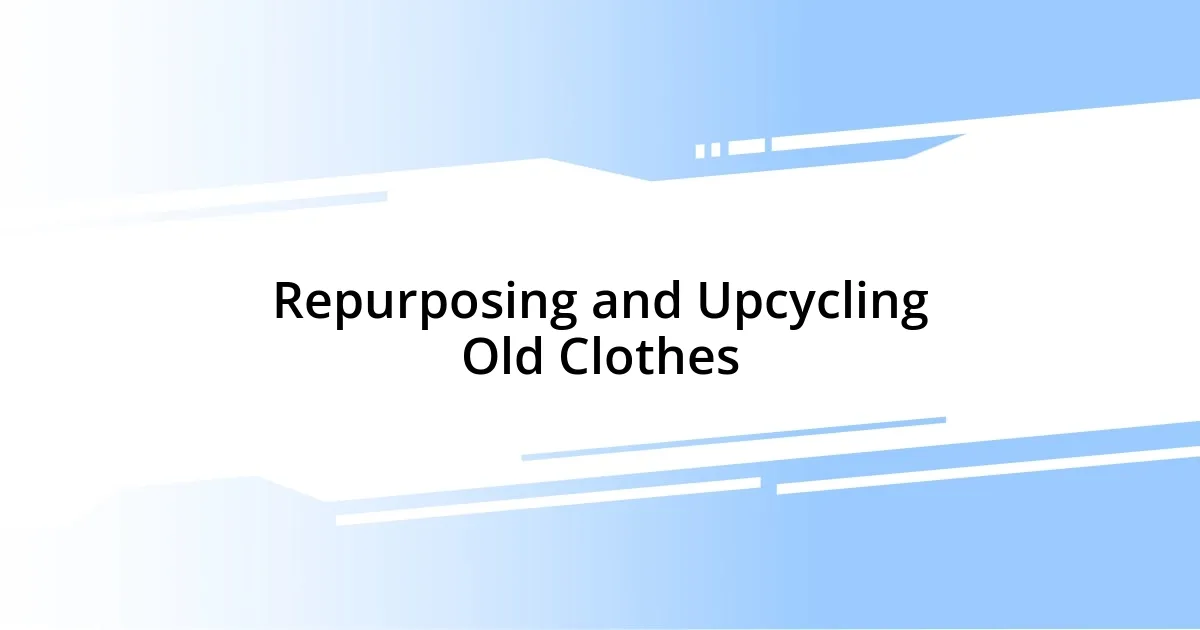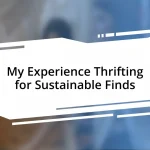Key takeaways:
- Fashion waste poses significant environmental and social challenges, with over 92 million tons of clothing discarded annually and worker exploitation in the fast fashion industry.
- Adopting mindful shopping habits and supporting sustainable brands can foster deeper appreciation and connection to fashion, reducing waste and promoting ethical practices.
- Embracing secondhand clothing and upcycling old garments encourages creativity, affordability, and a unique personal style while contributing to sustainability.

Understanding Fashion Waste
Fashion waste embodies the environmental and ethical challenges the clothing industry faces today. I often reflect on how the latest trends can lead us down a path of mindless consumption. Have you ever opened your closet and felt overwhelmed by clothes you’ve only worn once or twice? It’s a stark reminder of how easily our purchasing habits contribute to the growing mountains of textile waste.
One impactful moment for me was volunteering at a local clothing drive. As I sorted through piles of donated clothing, I felt both sadness and determination. The excess was staggering, revealing just how many garments people purchase but never truly use. This experience highlighted the crucial need for awareness in our buying choices and the importance of valuing what we already own.
In my own journey, I discovered that one person’s waste can be reframed as another person’s treasure. When I embraced second-hand shopping, I realized each piece has a story, giving it a richness that fast fashion lacks. I often wonder: what if we all shifted our mindset to treasure what we have, rather than endlessly chasing the next new thing? Together, we could significantly reduce fashion waste while embracing a more sustainable lifestyle.

Impact of Fashion Waste
Fashion waste has far-reaching implications, both for the environment and society. I remember a day when I learned about the staggering statistics surrounding textile pollution—over 92 million tons of clothes are dumped every year. It hit me hard, realizing that each shirt I choose to buy contributes to this overwhelming figure. It’s not just numbers; it’s our planet’s health at stake.
The social implications of fashion waste are equally profound. I once attended a workshop where a speaker passionately discussed how fast fashion often exploits workers in developing countries. Hearing those stories stirred a sense of urgency within me. The notion that my choices could uplift or harm someone far away made me rethink my purchasing habits. I’ve since found joy in supporting fair trade brands, knowing my purchases can foster positive change.
Lastly, the impact of fashion waste isn’t just abstract; it’s visceral. I still recall the feeling of holding a beautiful jacket, newly thrifted, that saved it from becoming landfill fodder. Each time I opt for second-hand, I feel a profound connection to the previous owner and their story—a silent acknowledgment that we can each play a part in alleviating the fashion waste crisis. It’s rewarding, really.
| Impact Area | Details |
|---|---|
| Environmental | Over 92 million tons of clothes end up in landfills each year, contributing significantly to pollution. |
| Social | Fast fashion often relies on the exploitation of workers, with many earning little to nothing while producing clothing. |
| Personal Growth | Choosing to shop sustainably or second-hand fosters a deeper connection to fashion and its impact. |

Assessing My Wardrobe Needs
As I dive into the task of assessing my wardrobe needs, I often find myself asking some tough questions. It’s all too easy to get caught up in the latest trends and add to the overwhelming collection in my closet. I recall a moment when I stood before my wardrobe, overwhelmed not just by the sheer number of items, but by a sense of guilt over all the clothes that had barely seen the light of day. That realization sparked a desire to get intentional about my wardrobe, leading me to evaluate not just what I own, but what I truly need.
Here are some key considerations I keep in mind while assessing my wardrobe needs:
- Current inventory: What do I already own, and how often do I wear each piece?
- Lifestyle changes: Have my needs shifted due to new activities or roles in my life?
- Seasonal relevance: Which items are appropriate for the current and upcoming seasons?
- Emotional connection: Are there pieces in my wardrobe that hold sentimental value but never see the light of day?
- Versatility: Do I have items that can be mixed and matched to create a variety of outfits?
By taking stock of my wardrobe thoughtfully, I not only minimize waste but also foster a deeper appreciation for the pieces I decide to keep. Each of these considerations helps me curate a space that truly reflects my needs and values.

Practicing Mindful Shopping Habits
Practicing mindful shopping habits has transformed how I approach clothing purchases. I remember a shopping trip where I impulsively grabbed several trendy pieces, only to return home and realize they didn’t fit my lifestyle at all. That day taught me the importance of asking myself, “Do I genuinely need this?” before adding something to my cart. Now, I carry a mental checklist to ensure I’m making thoughtful, informed decisions instead of just succumbing to the allure of a flashy sale.
I also find it helpful to apply the “one in, one out” rule. For every new item I consider bringing into my closet, I evaluate an old piece that I might part with. This practice not only keeps my wardrobe manageable but makes me genuinely reflect on each purchase’s value and utility. During one particularly tough decision, I reluctantly decided to let go of a pair of shoes that once made me smile. Realizing that my closet is a space to celebrate the pieces I love, rather than a drain on resources, has made letting go much easier.
When shopping, I also prioritize supporting sustainable brands and local artisans. I still feel a rush of excitement when I discover a unique piece from a small business or thrift store, knowing that my choices resonate beyond my wardrobe. I remember finding a handmade bag from a nearby craft fair—every stitch told a story, and I felt good about contributing to a smaller, ethical footprint. The heart behind those purchases drives home the message that fashion can be beautiful and responsible at the same time.

Exploring Sustainable Fashion Brands
Sustainable fashion brands are not just a trend; they genuinely align with my values and lifestyle choices. I recall the thrill I felt when I discovered a local brand that uses organic materials and ethical labor practices. Each piece I purchased felt like a small victory—not just for my wardrobe, but for supporting a movement toward responsible fashion. It raises the question: how can we, as consumers, make a difference in the fashion industry with our purchasing choices?
When exploring sustainable brands, I often prioritize transparency in their practices. It’s refreshing to see brands that openly share their sourcing methods and production processes. I remember stumbling across a brand that detailed every step of their supply chain. They even provided information on the artisans who crafted each piece! That kind of honesty resonates with me deeply, reinforcing my belief that ethical fashion is possible and necessary.
On my journey to sustainable fashion, I’ve also found joy in thrifting and vintage shopping. There’s an undeniable charm in wearing something that has a history, along with the satisfaction of giving a once-loved item a new lease on life. One of my favorite finds was a vintage dress that had a small tear, which I repaired myself, imbuing it with even more character. Can clothing tell stories? I believe they can, and every sustainable purchase I make becomes part of my own narrative, weaving together the past and present in a beautiful tapestry of fashion choices.

Embracing Secondhand Clothing Options
Embracing secondhand clothing options has truly revolutionized my wardrobe. I still remember my first thrift store expedition where I unearthed a stunning blazer that felt like it had lived many lives before. It sparked a joy in me, knowing that I was giving a new home to something unique while also being kind to the planet. Isn’t it exciting to think that every secondhand piece carries a story, waiting to be added to our own narratives?
Additionally, I find that thrift shopping encourages creativity in my style. It often leads me to mix and match pieces that I wouldn’t normally consider, like pairing a vintage skirt with a modern tee for a fun, casual vibe. There’s a thrill in the hunt, where you might stumble upon a funky sweater that feels like it was made just for you, and that sense of discovery is exhilarating. Have you ever found a gem that felt perfectly aligned with your personal style? It’s moments like these that solidify my belief in the beauty of embracing pre-loved clothing.
Moreover, I appreciate the affordability that comes with secondhand shops. It’s not uncommon for me to walk out with a handful of items for the price of a single new garment. That financial freedom allows me to experiment more with my style without guilt. I recall a moment at a flea market where I snagged five pieces for under $30, all of which have become staples in my wardrobe. It made me realize that sustainable fashion doesn’t have to break the bank; it can be accessible and fun!

Repurposing and Upcycling Old Clothes
Repurposing and upcycling my old clothes has become a rewarding pastime. One weekend, I took an old pair of jeans that I adored but hadn’t worn in ages. Instead of tossing them aside, I turned them into a cute denim bag. The satisfaction of carrying something I made, combined with the nostalgia of those jeans, brought a smile to my face every time I used it. Doesn’t it feel great to breathe new life into something that was just sitting in the back of your closet?
When it comes to upcycling, the possibilities are practically endless. I recently transformed a faded graphic tee into a trendy crop top that I now wear with my favorite high-waisted skirt. It felt empowering to create something stylish from a piece that was collecting dust. Have you ever experienced that rush of creativity when you realize you can tailor your clothes to fit your vision? For me, it’s like discovering hidden treasure in items I once considered obsolete.
I’ve also found joy in hosting upcycling workshops with friends. We gather our fabric scraps and old clothes, share ideas, and inspire each other. One friend crafted beautiful earrings from old t-shirts, while another made a stunning patchwork quilt from assorted fabric remnants. Every session is a reminder of how transformation can be a communal experience—a fun way to connect while reducing waste. It makes me wonder, what creative masterpieces can we all create when we put our minds together?












